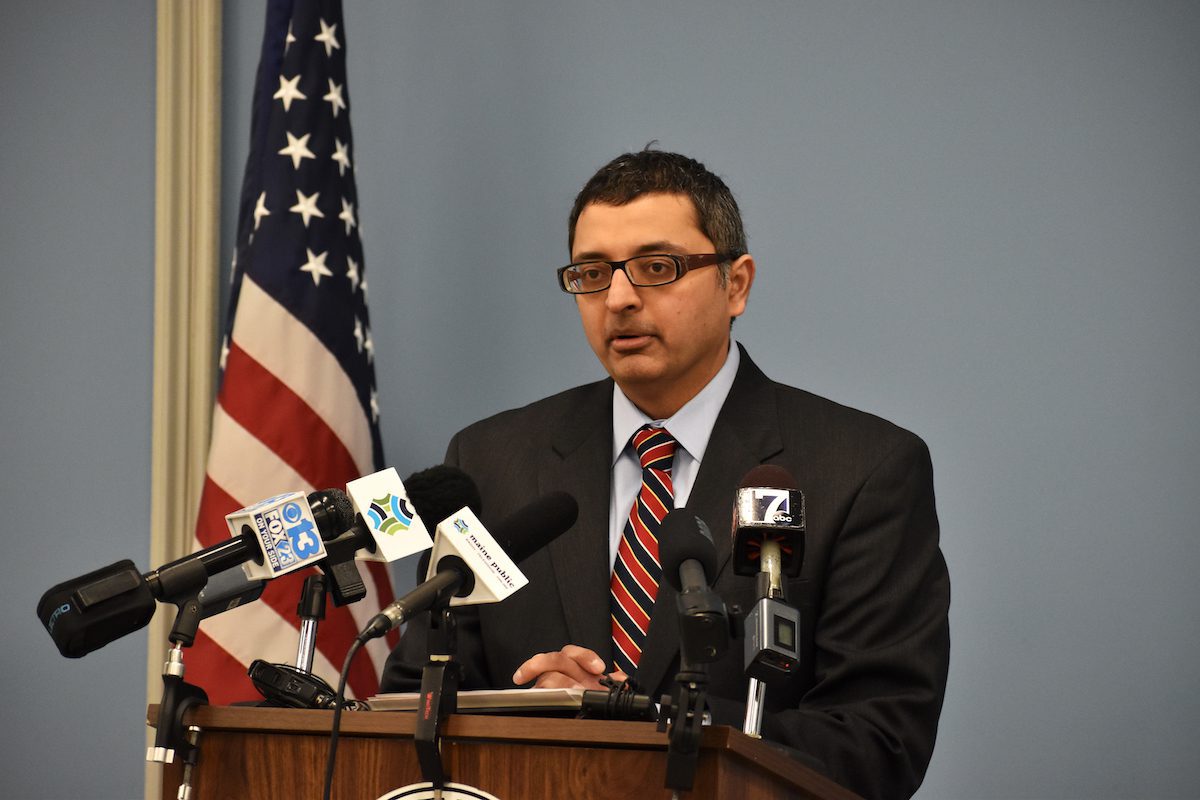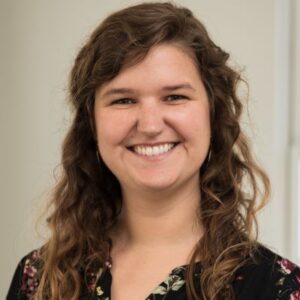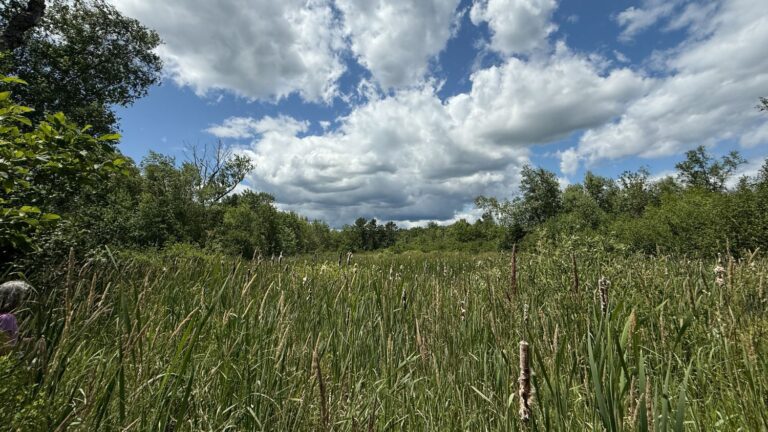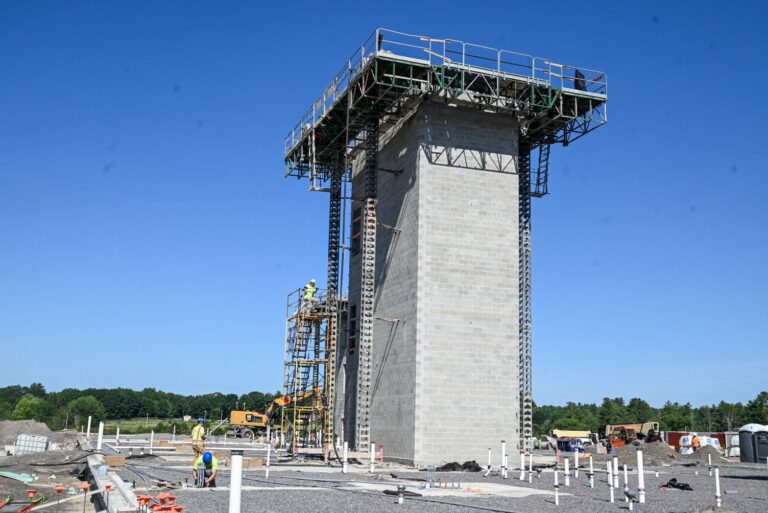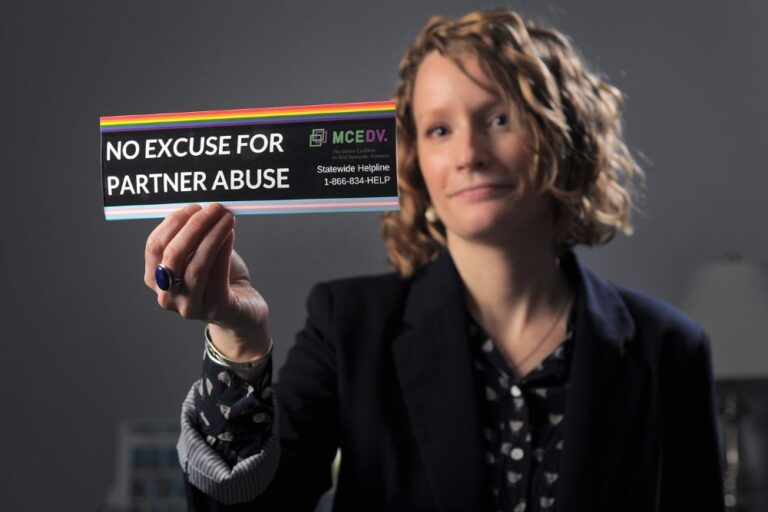As COVID-19 cases continue surging in Maine and the first vaccination doses offer some hope, Dr. Nirav Shah, director of the Maine Center for Disease Control and Prevention, spoke to health reporter Rose Lundy to reflect on the state’s pandemic response, and outline challenges and opportunities in 2021.
Here is a transcript of the Dec. 14 interview, edited slightly for length and clarity:
Rose Lundy: I know you’re very busy at the CDC so I do appreciate your time. My first question is, what do you think made Maine successful early on, and did it last or are these recent surges indications that that success has been undermined?
Nirav Shah: Well let’s start with how we got where we are. And you’re right, Rose, we have done favorably well compared to just about every other state, and maybe even many countries across the globe with respect to the way Maine people have responded to COVID-19. And that’s where I would start the answer. One of the reasons why is that I think in Maine, science means something. Though I know folks are going to say, “Well, wait a minute, I saw a guy somewhere who didn’t have a mask on.” Those things happen but when you take a look at reports and surveys of, for example, mask wearing, Maine people report wearing a mask 80-plus percent of the time. Compare that to much, much less in places like the Dakotas. So I think a large part of the reason that Maine favorably did well is because these scientific principles, this good public health guidance, actually means something.
Another reason is that we reacted and planned and prepared for things that we knew would be coming our way long before we even had our first case. Weeks before we even had our first case of COVID-19, we had already planned for having testing available. We had pushed on PPE to a number of health care sites, again, even before we had our first case. So that advanced preparation meant that when we did have our first cases, we were not caught flat-footed.
Another thing that I think really made a difference was we were able to work with folks, for example business community members and others, in a fashion to make sure that their interests are heard and balanced against what we thought was effective for public health. So there were a number of reasons that I think we did favorably well.
Of course, we have had a significant spike, just in the past eight weeks. But again, even relative to other states, we are still doing favorably well, even though the situation has gotten a lot worse. The national positivity rate right now stands at around 10 percent. Ours in Maine, it’s about 4.5 percent. It’s still a lot higher than it was before, but it’s still comparatively better than most everywhere else in the country.
RL: So do you see that still as a success when you compare?
Shah: I don’t think about response as success or failure. We’re still in a situation where over 250 Maine people have died and we were having multiple 100 cases per day. So I don’t see it as success. I see it as a situation where we were able to keep our case numbers so low for so long, such that when a national wave of cases came upon us, even though we experienced a significant increase, it was not as marked as in other states. Other states started high and went higher. We started low and went to medium.
RL: And what do you think will be the lasting impact of COVID-19 on public health, if any impact?
Shah: Oh, boy. Well, one can hope — and again hope is not a strategy — but one can hope the pandemic brings into sharp focus for everybody across the country, what it is that your local public or state public health department does. I think for a lot of folks, understandably, they knew there was a health department. Maybe they knew it was involved with restaurants. But beyond that, the scope of what a health department does, and our criticalicality with respect to, say, emergency response to situations like this, they probably may not have had the full depth or breadth of appreciation.
One of the things my colleagues and I hope is that after the pandemic, public health remains a clear focus, and thus the need to make sure that it’s funded at, for example, appropriate levels at the national level is not a debate we need to have. There will be other changes to public health as well. One of which that we’re starting to see is a growing interest in folks who want to work in public health. That’s a great thing. The more people we can get involved in our field, the better off we will all be, not just from a public health perspective but, in my own biased view, from a societal perspective.
RL: Was the director of the CDC as well known before this? I don’t know.
Shah: Perhaps not. And although I am certainly gratified by the support I have received, I think, Rose, this is an important thing for me to say: I’m just the guy who gets the privilege to talk about all of the work that my team is actually doing. When I get questions about outbreaks or PPE or lab testing or vaccine planning, it’s my team that’s doing all that and briefing me on it, working together as a team, within my agency, so that I have insight into what’s going on, and that I can then report and communicate that to others. So although I’m gratified by the reception and the warmth, I think it’s really important for folks to know that it’s a giant team of public health professionals here. They’re the ones that are really doing the work.
RL: Speaking of your team, do you have a timeline for when you and your staff will get the vaccine?
Shah: I don’t know about my staff, to be honest. I will tell you that for myself, where I am at right now is that, first of all, I will absolutely take the COVID-19 vaccine. Based on the scientific review that the FDA and the CDC conducted, many and much of which I listened in on or read reports of, I have no concerns about the safety or the efficacy of the COVID-19 vaccine, and I will absolutely take it when my turn comes up. I’m not sure about my staff. My staff are of different ages with different health conditions. So some may be ahead of the line. But I will absolutely take the vaccine when it is my turn to receive it.
RL: In terms of your age?
Shah: Yes. To be 100 percent clear, I am a guy in my 40s with no significant health conditions so I am way down in the phases. So that’s my thinking right now. I know counterparts of mine in other states have decided to be first in line and there are certainly benefits of that from a messaging perspective in order to generate confidence in the vaccine. I’ve thought about that and I guess no decisions have been made finally, but that’s just not how we do business. I’d rather wait for my turn in line based on my age and my thankful lack of health conditions, which may be into the summer. And if that’s when my turn in line comes up, then that’s when I’ll go.
RL: Kind of along that note, you say frequently that the vaccine isn’t going to be some magic fix to all of this and we’re going to have outbreaks and cases even after the vaccine is in the general public. Do you have an idea how long we could be in that stage? How long we could still be seeing outbreaks and cases?
Shah: Outbreaks of COVID-19, even after vaccines are widespread and widely taken, will still occur. Just as there are still outbreaks of measles or tuberculosis or mumps, even though we still have great vaccines. At least, as to measles and mumps, we have vaccines for those. There will continue to be COVID-19 outbreaks, probably for as long as I am in public health. Our hope is they are not as prevalent, as widespread, as great of magnitude, and don’t cause the same number of cases or deaths that the outbreaks we’re seeing now. They will still happen but hopefully at a far more muted rate.
RL: I think you’ve touched on this during the press briefing today but can you talk a little about the plan to get that vaccine to rural and older folks, especially how you can help those people come back for the second dose if they’re hard to reach?
Shah: That second dose is a very good point, Rose. Let’s talk generally about the plan, especially in rural areas. You know one of the things in Maine that I’ve seen is even rural areas are not too far from, say, a volunteer fire department. And so we are looking right now for ways that we can partner with front-line first responders who have a penetration and an ability to get to very rural parts of Maine. Now, will we be able to make it such that no one has to drive more than one or two miles? That may not be the case. But by working in concert with pharmacies, places like fire departments, as well as perhaps other public settings — parking lots where we can set up at a high school, or something of that nature — we believe we’ll be able to get good coverage of the vaccine. We’re hoping to make it as easy as possible for the widest number of individuals. It’s going to be a challenge, there’s no question about that. The second dose, in particular, provides a challenge. The goal really in getting folks to come back for their second dose is to convince them of the importance of why they came for their first dose in the first instance. We think that if we can get in the door for the first dose, the second dose will not be such a challenge.
RL: How are you working on getting people in the door for that first dose? For people who perhaps don’t tune into all the press briefings or don’t read all the frequent coverage, how do you reach them and how do you build their trust in the vaccine?
Shah: Let’s talk about reaching them first and then talk about confidence. As to reaching them, it will depend on which phase they are in. If they are, say, in Phase 1B, which is critical infrastructure and essential workers, we think it will perhaps be their employer who is the best suited to let them know, ‘OK, our time is up, our time is here, and it’s ready for our team to go get vaccinated.’ So for that phase it may be the employer. For other phases, for example those that focus on those over 65 or individuals with health conditions, it may be their health care provider because the health care provider can query the EMR, the electronic medical record system, and say, ‘OK, in my practice these are the people who are over 65 or who have serious medical conditions. Let me call them. Let me send them a note.’ So it will be different ways. Confidence in the vaccine is critical and the way you achieve confidence with anything is to talk with folks about it. There is no magic bullet when it comes to instilling confidence in a new thing. This is a new vaccine that’s been developed quickly with the technology that many folks haven’t heard of. It is completely understandable and we must recognize that people will have questions. That is a human thing, to have questions about all of this. Our job is not so much just to have answers. That’s sometimes the easy part. It’s to have conversations with people. It’s not about changing their mind. It’s about changing their behavior, and that is a completely different thing.
RL: Are you optimistic that you’ll be successful in getting enough people to get the vaccine?
Shah: I’m optimistic that with good, honest, thoughtful, transparent, respectful communication, we will get folks to where they need to be. But all of those things have to be in place. The communication has to be honest. We have to acknowledge that for some folks, they may have side effects, they may have a fever, they may have some pain in their arm. It’s got to be open. We can’t just do it in closed groups. It’s got to be transparent. Again, we’ve got to let folks know that there were folks who had fevers in the clinical trial. And it’s got to be respectful. All too often in situations like this, we treat people who disagree with us as if they are uneducated, uninformed, or as if we are trying to win a high school debate competition against them. But that does not change people’s behaviors. The only thing that has ever changed someone’s behavior is open, transparent and respectful communication.
RL: That leads really well into my next question. There were really intense debates this year about restrictions on gatherings and public health guidance and “shutting down the state.” And I wondered, how do you prevent that kind of political infighting that was so dominant in 2020 from interfering with the next stages of battling COVID-19 in 2021?
Shah: I think the way that we prevent it — which would be wonderful if that happened, if we were able to forestall that — I think the way we go about doing so is by starting the conversation now. Not letting folks bring the conversation to us, but by starting off by discussing openly what the vaccine will entail, what the process will look like, what the few side effects that there have been, what those look like, the percentages in which they occurred. I think by being proactive in the conversation, rather than reactive, we can help make sure that folks get their questions answered before they have time to spin questions in the conspiracies.
RL: OK, so being proactive about getting the information out there. President-Elect Biden has spoken a lot about what he wants to accomplish in his first days in office and I wondered, have you had any communication from the incoming Biden administration?
Shah: A little bit. I’ve had the privilege in connection with the society of state health officials, we’ve had the privilege to have communication with the Biden administration to talk about things like, for example, some of the IT requirements that will be needed to make sure we know what’s going on with vaccinations in our state.
RL: Have you had any indications about how the leadership might be different under the next administration?
Shah: The one thing I can note that I have seen already is that the Biden-Harris administration has already started reaching out to states in connection with the conversations I mentioned. And what our ask of them has been to enlist states to help them get their vaccine plans into action. Ultimately, many of the plans with respect to COVID response are effectuated at the state level. And what we have asked the Biden incoming administration to do is consult with states before decisions are made so we can provide input that will help make all of those plans be more successful. Thus far they have, and I’m encouraged that that type of collaboration at the federal-state level will continue.
RL: Did you feel like states had input leading up to now or is that something that you would want more of?
Shah: We did. I would want more of, though. We did get to have input and in some instances, the more the better, especially when we’re talking about massive logistics projects like vaccination. The more we are able to weigh in at the state level and say — ‘We don’t think that’s going to work because this, this and this. And how about you try this, this and this instead?’ — we think the better off we’ll be. We’ve had that opportunity previously as an organization of state health officials, but we look forward to having it more.
RL: You mentioned putting the plans into action. What are some of the roadblocks you’re concerned about as you think about Maine’s plan of action?
Shah: Well, having appropriate resources from our federal partners will be very helpful. Just to be clear, we’ll get the job done either way, but my twin goals for vaccination are to vaccinate with velocity and equity. And the more federal resources we have that are available to us, that is all the more quickly and efficiently we can accomplish both goals. We need federal assistance for very concrete things. For example, to have enough staff out there who can actually vaccinate, to help us think through this massive logistics operation or just to have the IT system in place so we know what’s going on. Having those federal resources will really help us get the job done that much more efficiently, that much more quickly and that much more equitably.
RL: Are you getting a sense that you’ll get those resources?
Shah: I know that discussions are underway and I know that Gov. Mills briefed the congressional delegation about what we are seeing, and what some of our needs are. I haven’t seen the latest out of D.C. to know where those conversations stand.
RL: Since we’re approaching certainly the end of this year and almost coming up on 12 months of the pandemic, I wonder if you could have a do-over this spring, perhaps February or January, what would you do differently, knowing what you know now about the virus?
Shah: You know, I think the one thing that I would do differently when this situation — if or when it happens again — I think the one thing that I would do differently is to level with people sooner rather than later. And I know that sounds strange, given the number of briefings we’ve done. One of the things I would do differently is do a COVID 101, a series of COVID webinars for folks, not clinicians but folks across Maine, just about what this is. What happened is we jumped right into COVID. Now, I started doing press briefings before we even had our first case so I had a little bit of chance to lay the groundwork, but I feel like we jumped to the middle of the race without starting it properly. So that’s one thing I would do. The other thing I would do for sure is put a sharper focus on day one on the disproportionate impact that COVID has had on racial and ethnic minorities. We have seen unacceptable disparities emerge across the state — categorically unacceptable — and if I were to do everything over again, I would put those concerns front and center. I believe that we did address them but clearly not sufficiently enough. And so that is something I think we would devote even more resources to make sure that those disparities, to the extent we could, did not open up in the way they did.
RL: Can you say a little bit about that because Maine did have, in the summer, the worst racial disparity in the nation — in terms of cases. Can you say a little bit about why that was and what the CDC did to try to rectify that?
Shah: There were a number of reasons why. They have to do with structural factors that govern where people live and how they work, where they work. The so-called social determinants of health. And those factors, again, were partly driven by those social reasons, but also these very, very challenging things like where people live and their housing conditions. I think one thing that would have remedied those is being more deliberate about offering people places to quarantine and isolate that were away from their families. Now, that is very difficult to do and whether that would have made the difference is an open question, but that’s something I think we could have done more.
RL: So providing a space for people?
Shah: Now, we did provide spaces, just to be clear. I don’t mean to suggest we didn’t, but could we have done so sooner? That’s the open question.
RL: Perhaps we’re already talking about this, but I was interested to ask what you think has been Maine’s greatest success during the pandemic and Maine’s greatest failure in its response?
Shah: I don’t really think about things in terms of successes or failures partly because we are just beginning the next chapter of what is a very, very long book. And so I’m not one for victory laps nor am I one for whatever the opposite of the victory lap is. That being said, I think there are things that other states have copied that we have done particularly well, specifically around case investigation, contact tracing, making sure that we were getting to folks within a short period of time. I also think the architecture of testing that we set up across the state is, again, one that other states copied from us. But are there things that we could have done better? Absolutely. For example, the discussion around racial and ethnic disparities. There’s no question about that. I know it sounds coy, but we are still in the middle of this race, so there will certainly be time to reflect upon what some of the high points and low points were. Right now our heads are down because we’re still in this.
RL: Kind of on that note, what is at the top of your mind as we go into 2021? What is the thing you’re thinking about the most?
Shah: Vaccinations. That’s what it comes down to. But bear in mind that just because vaccinations are rolling out, it’s not as if the other processes, that the other scaffolding and architecture that we created, can stop. We are adding a brand new massive logistics operation on top of a series of massive logistics operations. So, for example, PPE is still going out, testing is still happening, case investigation and contact tracing are still going on at gangbusters speed, but now we are adding a brand new set of work on top of all that. That’s going to be the focus of 2021. It’s keeping vaccines going while simultaneously keeping the other processes moving forward.
RL: When I hear you talk about all of the things going on, do you worry about CDC staff getting exhausted at some point? You’ve compared it to a marathon before.
Shah: Absolutely, every single day we worry about that, but that’s what our team does. Can you imagine if we just all decided to go on winter break? Can’t do that. So as much as I wish I could give my entire agency two weeks off for Christmas and New Year’s, there’s too much at stake.
RL: Well, I don’t want to take up your whole day. I know you have a busy schedule so my last question is just what makes you hopeful about 2021?
Shah: Well, there is hope that is around the vaccine, but bear in mind a vaccine alone doesn’t actually save anyone’s life. It’s vaccination that saves lives. So what gives me hope is that we across the state are on very strong footing with respect to vaccines, but we’ve got a very, very long way to go.
RL: Great. Well is there anything else you would like to say or add?
Shah: No, I appreciate you taking the time. I very much appreciate it.
RL: Thank you, too. I appreciate the time and I hope you have a wonderful holiday season.
Shah: Thanks, Rose.


